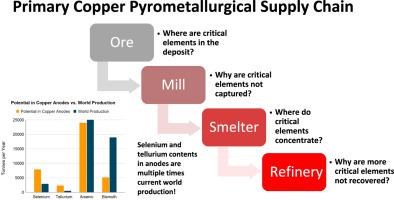Journal of Cleaner Production ( IF 9.7 ) Pub Date : 2021-05-01 , DOI: 10.1016/j.jclepro.2021.127207 Michael Moats , Lana Alagha , Kwame Awuah-Offei

|
The highly specialized materials needed for the de-carbonization of energy, smart devices and the internet of things have created supply concerns of critical elements used in these applications. Several critical elements are produced as by-products from base metal mining and processing. Increasing the capture of critical elements from existing operations should lead to a more resilient and sustainable supply of these elements. Towards this goal, this paper presents a review of the distribution behavior of five critical elements (selenium, tellurium, arsenic, antimony and bismuth) through the primary copper pyrometallurgical supply chain. This review identifies gaps in the distribution/concentration data of these elements in deposits and during mineral processing. Smelter dusts, refinery slimes and electrolyte are points of enrichment that can be targeted for additional recovery of these elements. Using published data, copper smelter dusts appear to contain enough arsenic and bismuth to meet the world's supply needs. Industrial data collected from 29 refineries and represents ~46% of the world's electrorefining production was extrapolated to examine the contained annual content of these five elements. Copper anodes contain 7900 tonnes/yr of selenium, 2300 tonnes/yr of tellurium, 24,000 tonnes/yr arsenic, 7100 tonnes/yr of antimony and 5100 tonnes/yr of bismuth. The selenium and tellurium contents are 2–3 times and 4–5 times more than the current world's annual production of these elements, respectively. While technology development in the processing of smelter dusts and refinery slimes could provide important breakthroughs, government and corporate collaboration are likely needed to encourage increased recovery of selenium, tellurium, arsenic, antimony and bismuth from the primary copper pyrometallurgical supply chain.
中文翻译:

回顾铜供应链中关键元素的弹性和可持续供应:回顾
能源脱碳,智能设备和物联网所需的高度专业化的材料引起了在这些应用中使用的关键元素的供应问题。从贱金属开采和加工过程中产生的一些关键元素是副产品。从现有业务中越来越多地获取关键要素将导致这些要素的供应更具弹性和可持续性。为了实现这一目标,本文介绍了通过主要的火法铜供应链对五个关键元素(硒,碲,砷,锑和铋)的分布行为进行了回顾。这项审查确定了矿床中和矿物加工过程中这些元素的分布/浓度数据中的差距。冶炼厂粉尘 炼油厂的煤泥和电解质是可以进一步回收这些元素的富集点。利用公开的数据,铜冶炼厂的粉尘似乎含有足够的砷和铋,可以满足世界的供应需求。从29个炼油厂收集的工业数据(约占世界电精炼产量的46%)被推算出了这五个元素的年含量。铜阳极含有7900吨/年的硒,2300吨/年的碲,24,000吨/年的砷,7100吨/年的锑和5100吨/年的铋。硒和碲的含量分别比目前世界上这些元素的年产量高2–3倍和4–5倍。











































 京公网安备 11010802027423号
京公网安备 11010802027423号